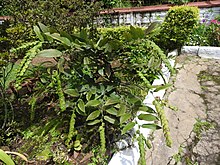Phyllodium pulchellum
| Phyllodium pulchellum | |
|---|---|

| |
| Scientific classification | |
| Kingdom: | |
| (unranked): | Angiosperms
|
| (unranked): | |
| (unranked): | |
| Order: | |
| Family: | |
| Subfamily: | |
| Genus: | |
| Species: | P. pulchellum
|
| Binomial name | |
| Phyllodium pulchellum | |
| Synonyms | |
| |
Phyllodium pulchellum is a plant in the family Fabaceae.
Medicinal[]
Traditional[]
In Bangladesh, a bark decoction is used for hemorrhage, diarrhea, poisoning and eye diseases. Flowers are used in biliousness.[2]
Chemical composition[]
Plant: Bufotenin and its methyl ether, DMT and its oxides, two tryptamine derivatives, gramine, , tryptophan bases, β-carbolines
Seeds: Galactomannan, L-glucosyl rhamnoside of physcion
Roots: Betulin, α-amyrin, β-sitosterol[2]
The alkaloids are mainly of three broad structural types, i.e. indole-3-alkylamine, beta-carbolines, and tetrahydro-β-carboline.[2]
References[]
- ^ "Phyllodium pulchellum". Germplasm Resources Information Network (GRIN). Agricultural Research Service (ARS), United States Department of Agriculture (USDA). Retrieved 2008-04-30.
- ^ a b c https://www.researchgate.net/publication/324561414_Phyllodium_pulchellum_A_Potential_medicinal_plant_-_A_review
Categories:
- Desmodieae
- Faboideae stubs
- Medicinal plant stubs